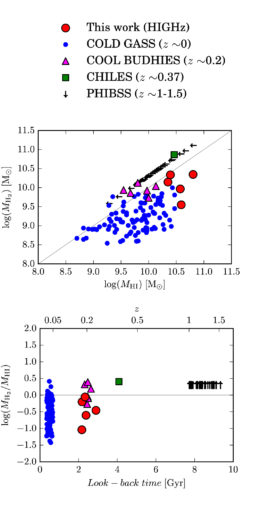Huge reservoirs of cold hydrogen gas — the raw fuel for star formation — lurk in galaxies throughout the universe. A new study examines whether these reservoirs have always been similar, or whether those in distant galaxies are very different from those in local galaxies today.

Left: Optical SLOAN images of the five HIGHz galaxies in this study. Right: ALMA images of the molecular gas in these galaxies. Both images are 30” wide. [Adapted from Cortese et al. 2017]
Molecular or Atomic?
The formation of stars is a crucial process that determines how galaxies are built and evolve over time. We’ve observed that star formation takes place in cold clouds of molecular gas, and that star-formation rates increase in galaxies with a larger surface density of molecular hydrogen — so we know that molecular hydrogen feeds the star-forming process.
But not all cold gas in the interstellar medium of galaxies exists in molecular form. In the local universe, only around 30% of cold gas is found in molecular form (H2) and able to directly feed star formation; the rest is atomic hydrogen (H I). But is this true of galaxies earlier in the universe as well?
Studying Distant Galaxies
Cosmological simulations have predicted that earlier in our universe’s history, the ratio of molecular to atomic hydrogen could be larger — i.e., more cold hydrogen may be in a form ready to fuel star formation — but this prediction is difficult to test observationally. Currently, radio telescopes are not able to measure the atomic hydrogen in very distant galaxies, such as those at the peak of star formation in the universe, 10 billion years ago.
Recently, however, we have measured atomic hydrogen in closer galaxies: those at a redshift of about z ~ 0.2–0.4, a few billion years ago. One recent study of seven galaxies at this distance, using a sample from a survey known as COOL BUDHIES, showed that the hydrogen reservoirs of these galaxies are dominated by molecular hydrogen, unlike in the local universe. If this is true of most galaxies at this distance, it would suggest that gas reservoirs have drastically changed in the short time between then and now.
But a team of scientists from the International Centre for Radio Astronomy Research in Australia, led by Luca Cortese, has now challenged this conclusion.

Top: molecular vs. atomic hydrogen gas in galaxies between z = 0 and z = 1.5. Bottom: the evolution of the molecular-to-atomic mass ratio with redshift. [Adapted from Cortese et al. 2017]
Adding to the Sample
Cortese and collaborators combined observations from the Atacama Large Millimeter/submillimeter Array (ALMA) and Arecibo to estimate the ratio of molecular to atomic hydrogen in five HIGHz-survey massive star-forming galaxies at a redshift of z ~ 0.2. They then combine these results with those of the COOL BUDHIES survey; they argue that, since the two surveys use different selection criteria, the combination of the two samples provides a fairer view of the overall population of star-forming galaxies at z ~ 0.2.
Intriguingly, the HIGHz galaxies do not show the molecular-gas dominance that the COOL BUDHIES galaxies do. Cortese and collaborators demonstrate that the addition of the HIGHz galaxies to the sample reveals that the gas reservoirs of star-forming disks 3 billion years ago are, in fact, still the same as what we see today, suggesting that star formation in galaxies at z ~ 0.2 is likely fueled in much the same way as it is today.
As telescope capabilities increase, we may be able to explore whether this continues to hold true for more distant galaxies. In the meantime, increasing our sample size within the range that we can observe will help us to further explore how galaxies have formed stars over time.
Citation
Luca Cortese et al 2017 ApJL 848 L7. doi:10.3847/2041-8213/aa8cc3

2 Comments
Pingback: tracing star stuff
Pingback: Il Carburante per Formare Stelle nelle Galassie | Accademia delle Stelle